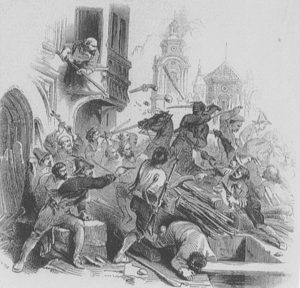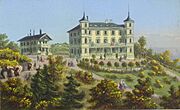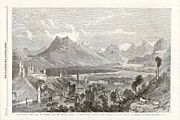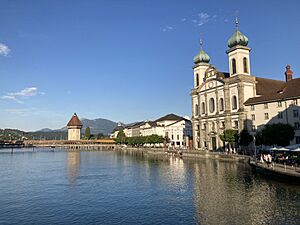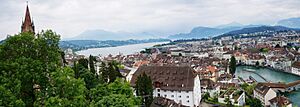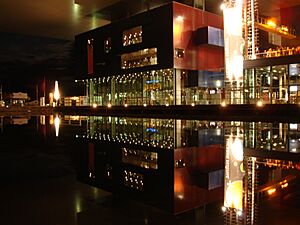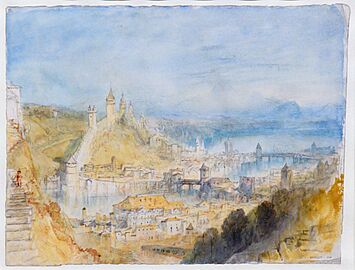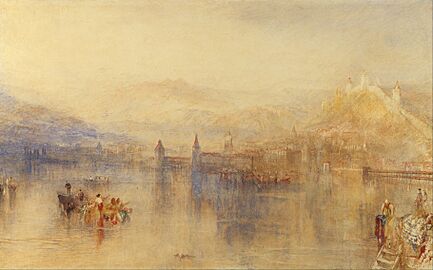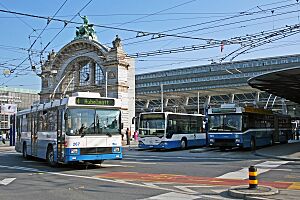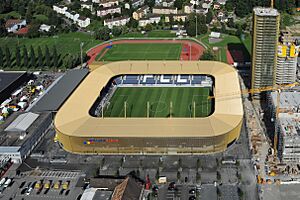Lucerne facts for kids
Quick facts for kids
Lucerne
|
||
|---|---|---|
|
Clockwise from top: Kapellbrücke, Löwendenkmal, Old town, City walls, Traditional frescoed building
|
||
|
||
| Country | Switzerland | |
| Canton | Lucerne | |
| District | Lucerne | |
| Area | ||
| • Total | 29.11 km2 (11.24 sq mi) | |
| Elevation
(Lake shore)
|
435 m (1,427 ft) | |
| Highest elevation
(Sonnenberg)
|
800 m (2,600 ft) | |
| Lowest elevation
(Rotsee)
|
422 m (1,385 ft) | |
| Population
(Dec 2020 )
|
||
| • Total | 82,620 | |
| • Density | 2,838.2/km2 (7,350.9/sq mi) | |
| Demonym(s) | German: Luzerner(in) | |
| Postal code |
6000
|
|
| Localities | Luzern, Littau | |
| Surrounded by | Adligenswil, Ebikon, Emmen, Horw, Kriens, Malters, Meggen, Neuenkirch | |
Lucerne (pronounced loo-SURN) or Luzern is a beautiful city in central Switzerland. It's located in the part of the country where people speak German. Lucerne is the capital of its canton (like a state) and is the biggest city in Central Switzerland.

About 82,000 people live in Lucerne. It's a very important place for business, travel, culture, and media in the region. The larger area around the city includes 19 towns and has about 220,000 people.
Lucerne is a popular place for tourists because of its stunning location. It sits on the shores of Lake Lucerne and the Reuss River. You can also see the famous mountains Pilatus and Rigi from the city, which are part of the Swiss Alps. One of Lucerne's most famous landmarks is the Chapel Bridge (called Kapellbrücke in German). It's a wooden bridge first built in the 14th century.
The official language in Lucerne is German. However, most people speak a local dialect of Swiss German called Lucerne German.
Contents
History of Lucerne
Early Times (750–1386)
After the fall of the Roman Empire around the 6th century, Germanic people called Alemannic became more powerful in what is now Switzerland.
Around the year 750, a monastery was founded in Lucerne. It was called the Benedictine Monastery of St. Leodegar. By the mid-800s, the area was known as Luciaria.
The name Lucerne might come from the Latin word for "pike fish," lucius, suggesting it was a good spot for pike fishing in the Reuss River. People also linked the name to the Latin word lucerna, meaning "lantern."
In 1178, Lucerne became independent from the monastery. The city itself was likely founded that same year. Lucerne became important because it was a key gateway for trade through the Gotthard route.
By 1290, Lucerne was a good-sized city with about 3,000 residents. Around this time, King Rudolph I von Habsburg took control of the monastery's lands, including Lucerne. The people were not happy with the increasing power of the Habsburg family. So, Lucerne joined with nearby towns to gain independence.
On November 7, 1332, Lucerne, along with three other forest cantons (Uri, Schwyz, and Unterwalden), formed the "eternal" Swiss Confederacy. This alliance was known as the Eidgenossenschaft.
Later, the cities of Zürich, Zug, and Bern also joined the alliance. With their help, the rule of Austria over the area ended. Lucerne's victory over the Habsburgs in the Battle of Sempach in 1386 settled the issue. This victory started a time of growth for Lucerne. The city quickly gained many rights that the Habsburgs had previously held back. By this time, Lucerne's borders were similar to what they are today.
From Town to City-State (1386–1520)
In 1415, Emperor Sigismund granted Lucerne Reichsfreiheit. This meant Lucerne became a strong and independent member of the Swiss confederacy. The city improved its buildings, collected its own taxes, and chose its own local leaders.
Around 1350, the city's population of 3,000 dropped by about 40%. This was due to the Black Plague and several wars.
In 1419, town records show the first witch trial against a man.
Catholic Stronghold (1520–1798)
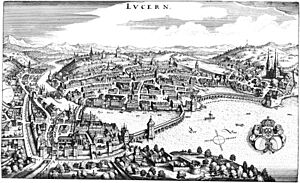
Lucerne was very popular and attracted many new residents among the growing towns of the confederacy. It remained mostly Roman Catholic. From 1453 to 1616, Lucerne held its own yearly passion play. This play lasted two days, with 12 hours of performance each day.
When the confederacy split during the Reformation after 1520, most nearby cities became Protestant. However, Lucerne stayed Catholic. After the Catholics won against the Protestants in the Battle at Kappel in 1531, the Catholic towns led the confederacy.
During this time, Jesuits first came to Lucerne in 1567. Their arrival was strongly supported by Cardinal Carlo Borromeo. However, Protestant cities like Zürich, Bern, and Basel eventually became more powerful. They defeated the Catholic forces in the 1712 Toggenburg War. Lucerne lost its leading position in the confederacy forever.
In the 16th and 17th centuries, wars and diseases became less common. As a result, the country's population grew a lot. In 1653, Lucerne was surrounded by a peasant army but quickly signed a peace treaty with the rebels.
Big Changes (1798–1914)
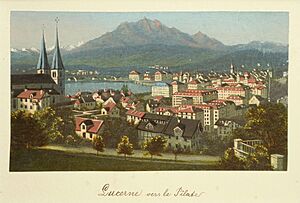
In 1798, the French army marched into Switzerland, nine years after the French Revolution began. The old Swiss Confederacy fell apart, and the government became more democratic.
The Industrial Revolution came to Lucerne quite late. By 1860, only a small part of the population (1.7%) worked in factories. This was much lower than the national average. Agriculture was still the main way people made a living. However, industries were attracted to the city from nearby areas. From 1850 to 1913, Lucerne's population grew four times larger as more people moved there.
Trains first connected Lucerne to Olten and Basel in 1856. Then, it was linked to Zug and Zürich in 1864, and finally to the south in 1897.
The 1804 play William Tell by Friedrich Schiller helped make Lucerne and its surroundings famous. Schiller had never visited Lucerne himself. But he was inspired by his wife Lotte and friend Johann Wolfgang von Goethe, who had both been there. Goethe had stayed in Lucerne in 1779 on his way to Italy.
In the late 1800s, Lucerne became a popular place for artists, royalty, and others to visit. The German composer Richard Wagner lived in Tribschen from 1866. Queen Victoria visited the city in 1868. She enjoyed seeing the Kapellbrücke and Lion Monument and talking with locals in German.
The American writer Mark Twain also made the city famous in his travel books after visiting in 1878 and 1897. In 1892, Swiss poet and future Nobel winner Carl Spitteler also moved to Lucerne. He lived there until he passed away in 1924.
Lucerne's popularity as a fancy destination made it one of the first places for modern tourism. Some of the city's most recognizable buildings are hotels from this time. These include the Schweizerhof Hotel (1845), Grand Hotel National (1870), and Château Gütsch (1879). The famous Swiss hotelier César Ritz worked as a manager at the National from 1878 to 1888.
The Great Fire of 1993
In August 1993, the Kapellbrücke (Chapel Bridge) in the city center had a big fire. It destroyed two-thirds of its inside paintings. The bridge was rebuilt and reopened in April 1994. The repairs cost about 3.4 million Swiss francs.
Merging with Littau
On June 17, 2007, people living in Lucerne and the nearby town of Littau voted to merge. This merger happened on January 1, 2010. The new city, still called Lucerne, has about 80,000 people. This makes it the seventh-largest city in Switzerland. This vote is expected to lead to talks with other nearby towns to create a larger city-region.
What is Lucerne Like?
Land and Weather
Lucerne is located where Lake Lucerne flows into the Reuss River. The city is on both sides of the river and at the end of the lake. The city center is right downstream from where the river leaves the lake. The city's neighborhoods climb the hills to the north-east and south-west. They also spread out along the river and lake banks. The recently added area of Littau is to the north-west.
The city also includes a small area on the south shore of Lake Lucerne, about 8 km away. This part is on the northern slopes of the Bürgenstock mountain. This section is completely surrounded by the lake and land from another canton. It doesn't have any big towns, but the top of the Bürgenstock is the highest point in the municipality.
The municipality covers an area of about 29.1 square kilometers (11.2 sq mi). About 28% of this land is used for farming, and 22.3% is covered by forests. Nearly half (47.6%) of the land has buildings or roads. The rest (2.1%) is non-productive, like rivers or mountains.
Between 1961 and 1990, Lucerne had rain on about 138 days each year. It received an average of 1171 mm (46.1 inches) of rain. June was the wettest month, with about 153 mm (6.0 inches) of rain over 14.2 days. February was the driest month, with about 61 mm (2.4 inches) of rain over 10.2 days. The climate here has mild differences between high and low temperatures, and it rains enough all year. It's known as a "Marine West Coast Climate."
| Climate data for Lucerne (1991–2020) | |||||||||||||
|---|---|---|---|---|---|---|---|---|---|---|---|---|---|
| Month | Jan | Feb | Mar | Apr | May | Jun | Jul | Aug | Sep | Oct | Nov | Dec | Year |
| Mean daily maximum °C (°F) | 4.0 (39.2) |
5.8 (42.4) |
10.9 (51.6) |
15.3 (59.5) |
19.4 (66.9) |
22.9 (73.2) |
24.9 (76.8) |
24.3 (75.7) |
19.6 (67.3) |
14.3 (57.7) |
8.2 (46.8) |
4.5 (40.1) |
14.5 (58.1) |
| Daily mean °C (°F) | 1.1 (34.0) |
1.9 (35.4) |
6.0 (42.8) |
9.9 (49.8) |
14.1 (57.4) |
17.6 (63.7) |
19.5 (67.1) |
18.9 (66.0) |
14.8 (58.6) |
10.3 (50.5) |
5.1 (41.2) |
1.9 (35.4) |
10.1 (50.2) |
| Mean daily minimum °C (°F) | −1.6 (29.1) |
−1.7 (28.9) |
1.5 (34.7) |
4.8 (40.6) |
9.1 (48.4) |
12.8 (55.0) |
14.6 (58.3) |
14.4 (57.9) |
10.8 (51.4) |
6.9 (44.4) |
2.2 (36.0) |
−0.8 (30.6) |
6.1 (43.0) |
| Average precipitation mm (inches) | 56 (2.2) |
61 (2.4) |
75 (3.0) |
96 (3.8) |
149 (5.9) |
164 (6.5) |
166 (6.5) |
170 (6.7) |
109 (4.3) |
88 (3.5) |
78 (3.1) |
78 (3.1) |
1,291 (50.8) |
| Average snowfall cm (inches) | 11 (4.3) |
14 (5.5) |
4 (1.6) |
1 (0.4) |
0 (0) |
0 (0) |
0 (0) |
0 (0) |
0 (0) |
0 (0) |
3 (1.2) |
13 (5.1) |
46 (18) |
| Average precipitation days (≥ 1.0 mm) | 9.7 | 8.7 | 11.0 | 11.2 | 13.1 | 13.5 | 12.7 | 12.7 | 10.2 | 10.0 | 9.5 | 10.5 | 132.8 |
| Average snowy days (≥ 1.0 cm) | 2.8 | 3.0 | 1.1 | 0.5 | 0.0 | 0.0 | 0.0 | 0.0 | 0.0 | 0.0 | 0.8 | 2.7 | 10.9 |
| Average relative humidity (%) | 83 | 78 | 72 | 68 | 71 | 72 | 71 | 75 | 80 | 84 | 85 | 85 | 77 |
| Mean monthly sunshine hours | 51 | 80 | 133 | 162 | 173 | 187 | 209 | 198 | 149 | 99 | 53 | 39 | 1,530 |
| Percent possible sunshine | 23 | 32 | 39 | 43 | 40 | 42 | 47 | 49 | 42 | 33 | 23 | 19 | 38 |
| Source: MeteoSwiss | |||||||||||||
People of Lucerne
| Largest groups of foreign residents 2021 | ||
| Nationality | Numbers | % of total (% of foreigners) |
|---|---|---|
| 3,772 | 4.56 (18.39) | |
| 2,225 | 2.69 (10.85) | |
| 1,376 | 1.66 (6.71) | |
| 866 | 1.05 (4.22) | |
| 843 | 1.02 (4.11) | |
| 783 | 0.95 (3.82) | |
| 713 | 0.86 (3.48) | |
| 629 | 0.76 (3.07) | |
| 499 | 0.60 (2.43) | |
| 428 | 0.52 (2.09) | |
| 365 | 0.44 (1.78) | |
| 323 | 0.39 (1.57) | |
As of 2021, Lucerne has a population of 82,771 people. About 24.78% of the people are foreign nationals. Most of these come from Europe (18.22%), followed by Asia (3.63%), Africa (1.85%), and America (0.97%). Over the last 10 years, the population has grown by 1.2%.
Most people in Lucerne (83.26%) speak German. Other common languages include English (7.45%), Italian (5.06%), and Serbo-Croatian (3.80%).
In 2013, about 15.7% of the population was aged 0–19 years old. About 33.8% were 20–39 years old, and 32.1% were 40–64 years old. Older adults (65 and up) made up about 19.4% of the population.
About 73.6% of adults (aged 25–64) in Lucerne have finished high school or gone on to higher education, like university.
In 2000, there were 30,586 households. About half of these (50.5%) had only one person living in them. Only about 2.8% were large households with five or more people.
The city grew around Sankt Leodegar Abbey, founded in 840 AD. Lucerne remained a strong Roman Catholic city for a long time. In 1850, 96.9% of the people were Catholic. By 2000, about 60% were Roman Catholic, and 15.5% were Protestant. Other religions included Christian denominations (3.33%), Muslim (3.07%), and Jewish (0.33%). About 10.61% said they did not belong to any organized religion.
How Lucerne Makes Money
In 2012, about 77,641 people worked in Lucerne. A small number (166 people) worked in 53 businesses in the primary sector (like farming). The secondary sector (manufacturing) employed 7,326 workers in 666 businesses. Most jobs were in the tertiary sector (services), with 70,149 jobs in 6,929 businesses. In 2013, 11% of the population received social assistance.
Lucerne is home to several big Swiss companies. These include AlpTransit Gotthard rail link, Schindler Group, Chronoswiss, Emmi, and the Luzerner Kantonalbank. Suva, an old accident insurance company, is also based here. The University of Lucerne, one of Switzerland's newer traditional universities, is also in the city. An international company called EF Education First is also located here.
Lucerne is known for being very business-friendly because of its low taxes. As of 2012, Lucerne had the lowest company tax rate at the canton level in Switzerland. It also has very reasonable personal income tax rates.
One of Lucerne's first export businesses was making scythes starting in the 14th century. Lucerne imported iron and steel. The city's blacksmiths made scythes and exported them to western Switzerland and northern Italy. The blacksmith workshops were located outside the city due to fire risks. These workshops used watermills to power their hammers.
Fun Things to Do
Famous Places to See
Since the city is built around the Reuss River where it leaves the lake, it has many bridges. One famous bridge is the Chapel Bridge (Kapellbrücke). It's a 204-meter (669 ft) long wooden covered bridge. It was first built in 1333 and is the oldest covered bridge in Europe. However, much of it had to be rebuilt after a fire in 1993. Partway across the bridge is the octagonal Water Tower (Wasserturm), a fort from the 13th century. Inside the bridge, there are paintings from the 17th century that show events from Lucerne's history.
Further down the river, the Spreuer Bridge (Spreuerbrücke or Mühlenbrücke, Mill Bridge) zigzags across the Reuss. Built in 1408, it has a series of medieval-style 17th-century paintings about the plague. These are called Dance of Death (Totentanzzyklus). The bridge also has a small chapel in the middle, added in 1568.
Old Town Lucerne is mostly north of the Reuss River. It still has many beautiful half-timber buildings with painted fronts. Parts of the old town walls are still on the hill above Lucerne, with eight tall watch towers. Another tower with a gate sits at the bottom of the hill by the Reuss River.
The two tall towers of the Church of St. Leodegar are on a small hill near the lake. This church is named after the city's patron saint. It was first built in 735, but the current building was put up in 1633 in the late Renaissance style. The towers, however, are from an older building. The inside of the church is very decorated. People often call it the Hofkirche (in German) or Hofchile (in Swiss-German).
Bertel Thorvaldsen's sculpture of a dying lion (the Lion Monument, or Löwendenkmal) is in a small park near Löwenplatz. This carving remembers the hundreds of Swiss Guards who were killed in 1792. This happened during the French Revolution when an armed crowd attacked the Tuileries Palace in Paris.
The Swiss Museum of Transport is a large museum that shows all kinds of transportation. This includes locomotives, automobiles, ships, and aircraft. You can find it by the lake in the north-eastern part of the city.
The Culture and Convention Center (KKL) is by the lake in the city center. It was designed by Jean Nouvel. The center has one of the world's best concert halls, known for its amazing sound quality.
The Richard Wagner Museum is on the lake at Tribschen. It is dedicated to the composer Richard Wagner. Wagner lived in Lucerne from 1866 to 1872, and his old home is now this museum.
Culture and Fun Events
Culture
Since plans for the new culture and convention center came up in the late 1980s, Lucerne has found a good balance between traditional and alternative culture. This led to a "culture compromise." The traditional culture includes the Lucerne Culture and Congress Centre (KKL) and the city theater (Luzerner Theater). It also includes smaller places like the Kleintheater, founded by comedian Emil Steinberger, who is from Lucerne. The Stadtkeller is a music restaurant in the old town. The KKL has a concert hall and the Museum of Art Lucerne (Kunstmuseum Luzern).
Alternative culture mostly happened at a former factory called Boa. Other places for alternative culture have since appeared in the same area. Boa used to host plays, but concerts became more common. This new use caused problems with new apartment buildings nearby because of noise. So, Boa was closed. A new place is being built in a less populated area. Some critics say the new place might not be as good for alternative culture.
Südpol is a center for performing arts in Lucerne. It hosts music, dance, and theater events. This venue at the foot of Pilatus opened in November 2008.
Lucerne is home to the Luzerner Sinfonieorchester, a top-level symphonic orchestra. It also has the 21st Century Symphony Orchestra. Both perform most of their concerts at the Lucerne Culture and Congress Centre.
Lucerne also hosts Keramikkonzerte, a series of classical chamber music concerts held throughout the year. There's also Zaubersee, a festival focused on Russian classical music.
Lucerne in Art
-
Lucerne from the Walls
William Turner, 1841
Tate Britain -
Lucerne from the Lake
William Turner, 1845
Morgan Library, New York City
Festivals and Celebrations
Every year, near the end of winter, Fasnacht (Carnival) takes over the streets of the old town. It's a colorful outdoor party where fun and chaos rule. People wear strange masks and amazing costumes. Guggenmusiken (carnival bands) play their instruments loudly and joyfully. Thousands of strangely dressed people sing and dance to chase away winter.
The Lucerner Fasnacht has religious, Catholic roots. It starts every year on the Thursday before Aschermittwoch (Ash Wednesday) with a big bang at 5 am called Morgenwacht (Morning Watch). There are big parades in the afternoon on Schmotzige Donnerstag (literally: Lardy Thursday) and the following Monday, called Güdismontag (literally: Paunch Monday). These parades attract tens of thousands of people.
Lucerne's Carnival ends with a grand finale on Güdisdienstag (literally: Paunch Tuesday) evening. This is the Monstercorso, a huge parade of Guggenmusiken, lights, and lanterns, with an even bigger audience. More recently, a fourth Fasnacht day has been added on the Saturday between the other Fasnacht days, called Rüüdige Samstag. On this day, mainly indoor balls take place.
From evening until dawn on Schmotzige Donnerstag, Güdismontag, and after the Monstercorso, many bands wander through the old part of the city playing typical Fasnacht tunes. Until midnight, the historical part of the city is usually packed with people joining in. A large part of the audience also dresses up in costumes, especially in the evenings.
The city hosts many famous festivals throughout the year. The Lucerne Festival for classical music happens in the summer. Its orchestra, the Lucerne Festival Orchestra, is made up of some of the best musicians in the world. In June, the pop music festival B-Sides takes place in Lucerne. It focuses on international acts in alternative music, indie rock, and experimental rock.
In July, the Blue Balls Festival brings jazz, blues, and punk music to the lake promenade and the Culture and Convention Center. The Lucerne Blues Festival is another music festival, usually in November. Since spring 2004, Lucerne has hosted the Festival Rose d'Or for television entertainment. In April, the well-known comics festival Fumetto attracts people from all over the world.
As the cultural center of a more rural area, Lucerne often holds different folklore festivals. One example is the Lucerne Cheese Festival, held every year. In 2004, Lucerne was the center of attention for Swiss Wrestling fans. It hosted the Swiss Wrestling and Alpine festival (Eidgenössisches Schwing- und Älplerfest), which happens every three years in a different place. A national music festival (Eidgenössiches Musikfest) brought marching bands from all over Switzerland in 2006. In summer 2008, the yodelling festival (Eidgenössisches Jodlerfest) had a similar impact.
The 2021 Winter Universiade was planned to be hosted by Lucerne. However, it was canceled because of the COVID-19 pandemic.
Getting Around Lucerne
After Ferdinand von Zeppelin landed his airship in Lucerne in 1909, the city became a leader in Switzerland's aviation industry. In February 1910, the country's first air transport company was founded. It was the second in the world after DELAG in Germany. In July of the same year, the first airship hangar was built at Tribschenmoos. The company offered airship flights until 1914 without any major accidents.
Lucerne has a well-developed and efficient transport system. The main operator, Verkehrsbetriebe Luzern (VBL), runs both trolleybuses in Lucerne and motor buses in the city and to nearby towns. Other companies, like PostAuto Schweiz and Auto AG Rothenburg, provide bus services to other villages.
Lucerne is one of Switzerland's main train stations. It is well-connected to the rest of Switzerland by train services. These are run by Swiss Federal Railways (SBB CFF FFS), the Südostbahn SOB, the BLS, and the Zentralbahn (zb). There are 40 trains per day between Lucerne and Zürich, with a travel time of about 48 minutes. Zurich Airport can be reached in just over an hour.
Next to the station is Luzern Bahnhofquai. From here, ships of the Lake Lucerne Navigation Company travel to different places on Lake Lucerne. Between April and mid-October, the tourist-focused Gotthard Panorama Express connects Lucerne with Lugano once a day. It travels by boat along Lake Lucerne and then by train over the historic high-level Gotthard route.
Three other train stations are within the city limits. Lucerne Allmend/Messe is near the Swissporarena in the south. Luzern Littau is in the former municipality of Littau. Luzern Verkehrshaus is next to the Swiss Museum of Transport in the east.
Lucerne's city transport system is part of a larger fare network called passepartout. This system covers all public transport in the cantons of Lucerne, Obwalden, and Nidwalden.
A funicular (a type of cable railway), Gütschbahn, connects the city to Château Gütsch, which is 90 meters (295 ft) higher. The Standseilbahn Hotel Montana runs from the lakefront to Hotel Montana. From 1912 to 1978, there was also the Dietschibergbahn at Dietschiberg.
Sports in Lucerne
There are several football clubs in the city. The most successful one is FC Luzern. It plays in Switzerland's top league, the Swiss Super League. The club plays its home games at the new Swissporarena, which can hold 16,800 fans.
The city's main hockey team is HC Luzern. It plays in the Swiss Second League, which is the fourth level of Swiss hockey. They play their home games in the 5,000-seat Swiss Life Arena.
In the past, Lucerne also had successful teams in men's handball and women's volleyball and softball.
Lucerne has a long history of horse sports. It used to co-host CSIO Switzerland, an international show jumping event, until it moved to St. Gallen in 2006. Since then, the Lucerne Equestrian Masters has replaced it. There is also an annual horse racing event, usually in August.
Lucerne hosts the final part of the World Rowing Cup every year on Rotsee Lake. Many World Rowing Championships have been held in Lucerne. These include the very first World Championships in 1962, and then again in 1974, 1982, and 2001.
Lucerne hosts the annual Spitzen Leichtathletik Luzern track and field meeting. This event attracts world-class athletes like Yohan Blake and Valerie Adams.
The city also has places for ice-hockey, figure-skating, golf, swimming, basketball, rugby, skateboarding, climbing, and more.
Lucerne hosted the FIVB Beach Volleyball World Tour event Lucerne Open in 2015. It also hosted the FIVB Beach Volleyball U21 World Championship in 2016.
Images for kids
-
Lucerne's Lion Monument remembers the Swiss Guards of Louis XVI who were killed in 1792 during the French Revolution
Notable People
See also
 In Spanish: Lucerna (ciudad) para niños
In Spanish: Lucerna (ciudad) para niños










